|
July 2005
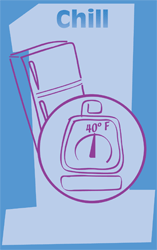 |
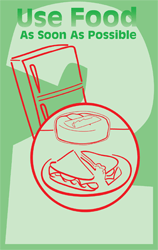 |
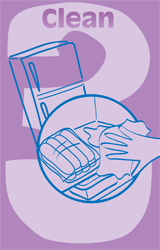 |
(This document also available in PDF, 766 KB, and en Español (Spanish))
You've probably heard or read about Listeria in the news. This foodborne bacteria can grow at refrigerator temperatures, and it causes listeriosis, an illness that can be particularly harmful to at-risk groups. These groups include pregnant women and their unborn babies, newborns, older adults, and other people with weakened immune systems (such as those with HIV/AIDS, cancer, diabetes, kidney disease, and transplant patients).
But, here's the good news – there are some simple ways all consumers can reduce their risk for listeriosis. It's all in this helpful booklet, Special Handling for Ready-to-Eat, Refrigerated Foods. And, it's easy!
The U.S. Food and Drug Administration (FDA), the Centers for Disease Control and Prevention (CDC), and the U.S. Department of Agriculture (USDA) recommend that consumers follow these three easy steps to help prevent listeriosis:
 |  |  |
Keeping the refrigerator at 40°F or below is important because – unlike most foodborne bacteria – Listeria will grow in the refrigerator, and it will grow faster at refrigerator temperatures above 40°F. And, the longer ready-to-eat, refrigerated foods are stored in the refrigerator, the more time Listeria has to grow. Finally, Listeria can spread from one food to another through spills in the refrigerator. That's why keeping the refrigerator clean is also important!
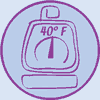
People with weakened immune systems are not able to effectively fight illness, so listeriosis can be particularly serious for at-risk people. If you're at risk or if you're preparing food for someone who's at risk, read on for the specific things you should know...
Reducing Your Risk for Listeriosis: 3 Easy Steps
Refrigerator Thermometers: A Must-Have for Food Safety!
Frequently Asked Questions
At-Risk Groups: Why Some People Face Special Risks
To Eat or Not to Eat?
4-Step Food Safety: A Reminder to Keep Food Safe!
Resources
Here are three very specific things you can do to help prevent listeriosis.
| Chill...
...at the Right Temperature
| Use...
...Ready-to-Eat Foods ASAP!
| Clean...
...the Refrigerator
|
New studies show that Listeria can grow over time at refrigerator temperatures above 40°F (4°C). And, the longer ready-to-eat, refrigerated foods are stored in the refrigerator, the more chance Listeria has to grow.
Through food handling and spills, Listeria in refrigerated food can spread to other non-contaminated foods. The good news is – cleaning the refrigerator will often prevent the spread of Listeria.

To reduce your risk for listeriosis, it's important to use an appliance thermometer made specifically for use in a refrigerator or freezer.
For safety, it is important to verify the temperature of refrigerators and freezers. Refrigerators should maintain a temperature no higher than 40°F (4°C). Frozen food will hold its top quality for the longest possible time when the freezer maintains 0°F (-18°C). An appliance thermometer can be kept in the refrigerator and freezer to monitor the temperature.
If possible, buy two appliance thermometers – one for your refrigerator and one for your freezer. The refrigerator should register at 40°F (4°C) or below. The freezer should register at 0°F (-18°C).
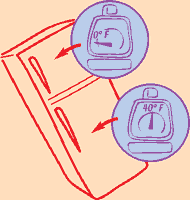
It's a harmful bacterium that causes a foodborne illness called listeriosis. It's found in the environment – soil, water, decaying vegetation, and the intestinal tract of animals. Listeria can grow at refrigerator temperatures, whereas most other foodborne bacteria do not. If food is processed, packaged, or handled in unsanitary conditions, it can become contaminated with Listeria. This is of particular concern because most ready-to-eat, refrigerated foods are not reheated before eating – a step that would kill Listeria, if it were in the food.
Good manufacturing and handling practices must be followed during food processing and at retail in order to prevent contamination. That's why government agencies monitor food and inspect processing plants, grocery stores, and restaurants regularly to ensure that the food supply is safe.
Listeria can grow at refrigerator temperatures, whereas most other foodborne bacteria do not. So the temperature you store your food at is important – check your refrigerator to make sure it is at 40°F or below.
The symptoms can take a few days or even weeks to appear and may include fever, chills, muscle aches, nausea, and diarrhea or upset stomach. If infection spreads to the nervous system, then headache, stiff neck, confusion, loss of balance, or convulsions can occur.
Healthy adults and children occasionally get infected with Listeria, but they rarely become seriously ill. However, for people in at-risk groups: pregnant women and their unborn babies, newborns, older adults, and others with weakened immune systems, listeriosis can be particularly harmful. These people face the risk of serious health problems – even death.
In pregnancy, an infected mother may experience only a mild, flu-like illness, or may not feel sick at all, yet the infection can still severely affect her unborn baby. That's why preventing listeriosis is extremely important. Listeriosis can lead to miscarriage, premature labor, the delivery of a low-birthweight infant, and a wide range of health problems for a newborn or even infant death (see At-Risk Groups and To Eat or Not to Eat?).
But, there are some easy ways you can reduce your risk for listeriosis (see Reducing Your Risk for Listeriosis: 3 Easy Steps).
See your health-care provider immediately. And, if you become ill after eating food outside of your home, such as at a restaurant or deli, also call your local health department so the department can investigate to see if there's a serious foodborne illness in the area.
A health-care provider may perform a blood test to check for listeriosis. Antibiotics may be prescribed by a health-care provider to get rid of infection.
During pregnancy, a health-care provider may prescribe antibiotics that are safe for the unborn baby to get rid of the mother's infection. In most cases, antibiotics also prevent infection of the unborn baby or newborn. Antibiotics may also be given to babies who are born with listeriosis.
Don't eat any food that's recalled and removed from grocery store shelves. Always return recalled food to the place where you bought it. For the latest product recalls, visit: Recalls.gov.
The risk of a person developing a Listeria infection after consuming a contaminated product is very small. If you've eaten a contaminated product and you are pregnant, then contact your health-care provider. Otherwise, if you've eaten a contaminated product and do not have any symptoms, it's not recommended that you have any tests or treatment, even if you are in a high-risk group. However, if you are in a high-risk group, have eaten the contaminated product, and within two months become ill with fever or signs of serious illness, you should see your health-care provider immediately.
Pregnant women are about 20 times more likely to get listeriosis than other healthy adults. An estimated 1/3 of all Listeria cases occur in pregnant women. Older adults have the highest risk for death, along with unborn babies.
Some people are more likely than others to get sick from harmful foodborne bacteria. And once they're sick, they face the risk of serious health problems – even death. This is particularly likely to happen with older adults and people with major medical problems.
In essence, people with weakened immune systems are not able to effectively fight illness. That's why preventing listeriosis is so important!
Here's a chart of who's at risk and why:
| Who's At Risk? | Why? |
|---|---|
| Pregnant women |
|
| Unborn babies and newborns |
|
| Older adults |
|
| Other people with weakened imune systems (transplant patients and those with HIV/AIDS, cancer, diabetes, kidney disease, etc.) |
|
Careful food preparation and selection practices will help reduce the risk for developing listeriosis.
Here are additional tips for preparing or serving food for at-risk consumers.
| Do not eat: | It's okay to eat: |
|---|---|
| Hot dogs and luncheon meats – unless they're reheated until steaming hot. | Steaming hot, thoroughly reheated hot dogs and luncheon meats. |
| Soft cheeses, such as Feta, Brie, Camembert, "blue-veined cheeses," or "queso blanco," "queso fresco," or Panela – unless they're made with pasteurized milk. | Soft cheeses labeled as made with pasteurized milk. |
| Refrigerated pâtés or meat spreads. | Canned or shelf-stable pâtés or meat spreads. |
| Refrigerated smoked seafood – unless it's in a cooked dish, such as a casserole. (Refrigerated smoked seafood, such as salmon, trout, whitefish, cod, tuna, or mackerel is most often labeled as "nova-style," "lox," "kippered," "smoked," or "jerky." These types of fish are found in the refrigerator section or sold at deli counters or grocery stores and delicatessens.) | Canned or shelf-stable smoked seafood. |
| Foods that contain unpasteurized milk. | Foods that contain pasteurized milk. |
| Do not drink: | It's okay to drink: |
| Unpasteurized milk | Pasteurized milk |

Studies show that pregnant Hispanic women may have a higher incidence of listeriosis than pregnant non-Hispanic women. This is most likely because they might make and eat homemade soft cheese and other traditional foods made from unpasteurized milk. "Queso fresco" - a traditional homemade cheese, prepared from unpasteurized milk and widely consumed by Hispanics – has led to miscarriages, premature delivery, and death of newborns caused by Listeria.
To prevent the risk of listeriosis, Hispanic pregnant women should not eat homemade soft cheeses and other traditional foods made from unpasteurized milk. Like all other pregnant women and people in at-risk groups, they should follow the food safety precautions outlined at left. You can purchase commercially- made "queso fresco" and "queso blanco" that are made from pasteurized milk. Check the label to make sure they're made with pasteurized milk.
To reduce your risk for listeriosis and other foodborne illnesses, everyone should follow these 4 Simple Steps.
Tips in bold are especially important in preventing listeriosis.




For more information about listeriosis, visit:
An important advisory on how to safely handle refrigerated, ready-to-eat foods and avoid listeriosis.
Frequently asked questions and answers about listeriosis.
Available online in English and Spanish.
Latest Listeria news, fact sheets, consumer information, resources, procedures, and guidance on foodborne illness from FSIS. Includes "Ask Karen," the FSIS virtual representative who answers food safety questions 24/7.
(Contact us with questions concerning dairy foods and shell eggs, produce, seafood, and processed foods that are not made with meat and poultry products.)
(Contact us with questions concerning meat, poultry, and egg products.)